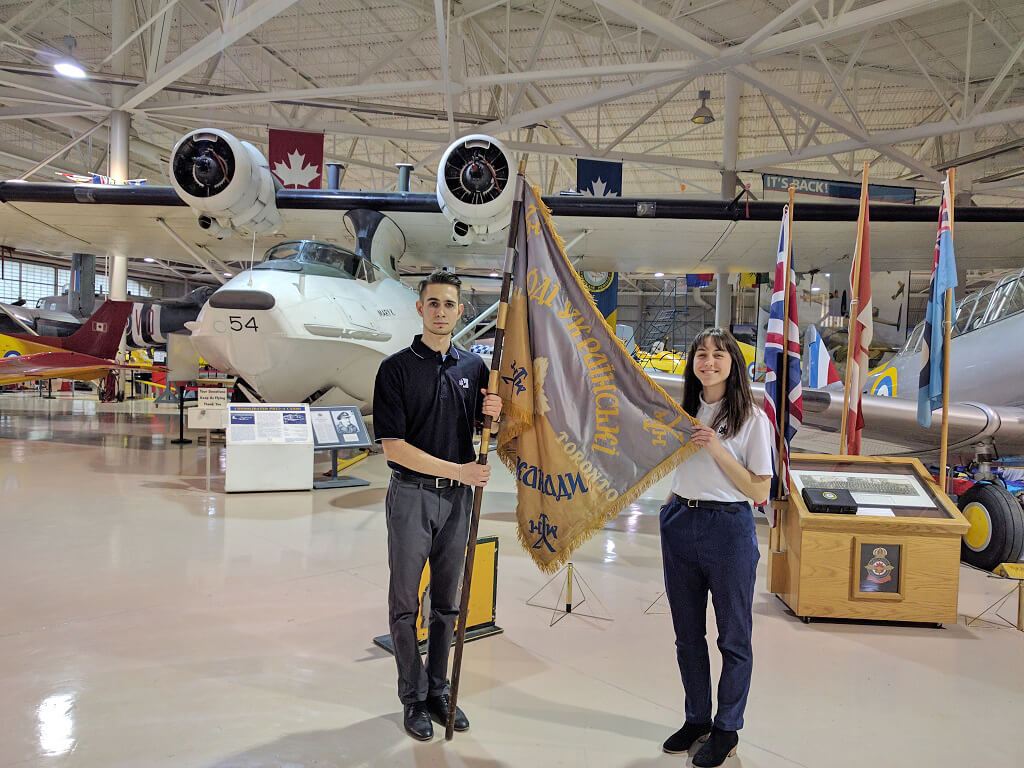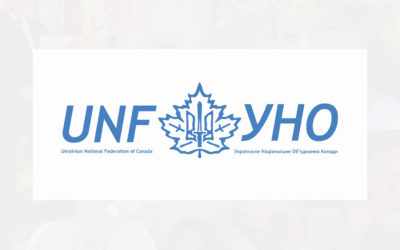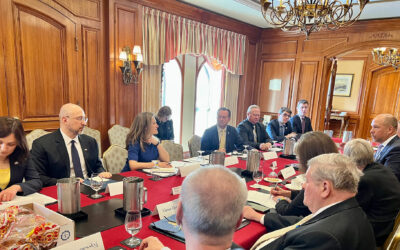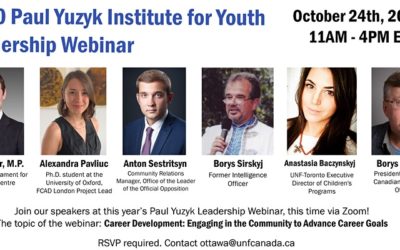Kateryna Bandura for New Pathway, Toronto.
The Canadian Warplane Heritage Museum opened its doors for the Ukrainian National Youth Federation (MYHO) last Saturday, May 13, inviting a group of five MYHO members and five Sokil members to spend the night among the planes. The program (called “Nite Ops”) is limited to groups such as cadets, scouts, and guides, but the Museum made an exception for MYHO upon learning the extraordinary contribution of MYHO’s early members to Canada’s WWII war effort, specifically about MYHO’s flight school established in 1938 in Oshawa. The school trained young Ukrainian men to become pilots, captains, navigators and paratroopers, who later joined the RCAF and fought in the Second World War. In their honour, today’s MYHO members raised their flag at colours ceremony at the Museum.
The knowledge about MYHO’s flight school was fading, until Anastasia Baczynsky (youth programing director at the Ukrainian National Federation of Canada) began researching a picture of Sen. Paul Yuzyk and three other men standing by a plane with MYHO emblem on its tail. UNF Oshawa’s Dan Cherkas helped the research greatly by lending the school’s archive to Anastasia. The archive, compiled on Manila paper, belonged to Mike Wladyka, the flight school’s principle and instructor. The album stores articles, personal photographs, ribbons, flight training punch cards, raffle tickets and other artefacts.
The materials became foundation for Anastasia’s program for MYHO members. MYHO’s trial trip to the Museum last Saturday was a week after the anniversary of the first Aviation day in Oshawa organized by MYHO back in 1938. At the Museum, both MYHO and Sokil members learned about the contributions of Ukrainians to the Canadian war effort from Cpt. Andre Sochaniwsky (President of the Ukrainian War Veterans Association of Canada), explored the physics of a flight, and toured the Museum’s restricted grounds under supervision of the staff. The moment of true pride was the flag raising ceremony, with MYHO’s flag waving at the Museum for the first time ever honouring fallen MYHO members.
A bit of history
In 1937, MYHO made a proposal to the UNF National Executive to start a flight school. The school was supposed to prepare pilots and paratroopers for Canadian Armed Forces and at the same time keep the Ukrainian community together. By serving Canada this way, the youth felt that they would serve Ukraine in some measure too. The National Executive delegated the responsibility to the UNF Oshawa.
MYHO in Oshawa began raising the funds for a training plane which costed $1,325 (more than $18,000 in today’s money). They sold tickets to and staged a play titled “Navala”, collected donations from the community and raffled a car donated by General Motors, with 10,000 tickets (worth $1 each). The money were to be spent on the plane, gas, training and other necessities. In total, they raised $500. The New Pathway encouraged the hromada to contribute and facilitated the collections across Eastern Canada.
The official opening of the school was on February 13, 1938 at the UNF hall, with the mayor of Oshawa Alex McLeese attending who was made an honourary member of the School. The School was organized as a private club and membership fees applied. Mike Wladyka became the principal and instructor, and trained the MYHO boys to become pilots. They flew a brand new Canadian-made Auster observation-training plane, which they named Yevhen, in honour of Yevhen Konovalets. Remarkably, the push from the Ukrainian community and the needs of the MYHO flight school led to the creation of a small municipal airport in Oshawa, which exists to this day.
MYHO members involved with the flight school were ready to join the fight when the war broke out in 1939. They joined the RCAF as trained pilots, flight captains, navigators, and paratroopers. Many of them never made it back home. One of the MYHO members, who went to fight overseas, was Flight Sergeant Navigator Eugene Salmers. Eugene advanced further in RCAF’s officers ranks. The New Pathway’s article from June 1942 describes how tragic his death was to MYHO, his community, the choir where he sang, and most of all to his mother, who could not accept her son’s death and required constant doctor’s supervision. The Canadian Warplane Heritage Museum lists his name in its book of commemoration.
Once MYHO members joined the war and the school closed down, debates arose about Yevhen’s destiny. Eventually the RCAF used it as its own training plane. Yevhen’s further fate remains unknown, but Mike Wladyka’s archive has a picture of Yevhen’s full registration number: CF-BGV, which remains in Toronto’s Ministry of Transportation archives. Anastasia plans to track the number and find out the final destination of Yevhen. “It would be nice to have some kind of closure”, she says. “This is a very important part of MYHO’s history. MYHO gave a lot to the war effort – they served faithfully and they died. And MYHO should be very proud of that and should be aware of this part of their identity.”
All this information was in Mike Wladyka’s archive, which Anastasia turned digital to preserve the memory of the school. The fate of the physical copy is being discussed, and there is interest on the part of the Canadian Warplane Heritage Museum to look at the archive and perhaps put it on display.
The importance of the trip to the Museum
The archive serves as a foundation for Anastasia’s program for MYHO and Sokil. The point of the program, she explains, is to make the Ukrainian Canadian youth aware that Ukrainians served Canada loyally, and that this is part of who they are. “MYHO kids should feel pride in the organization’s contribution to Canada, and feel pride of belonging to the organization. Because of that service they are leaders and the program is meant to build leaders.”
MYHO’s president Yura Dunets also believes that the program is going to succeed: “MYHO changed things back in 1930s and 40s. They anticipated that something was going to happen in the world and they prepared for it by starting this flight school. They took initiative – and they were ready to fight for their identity on foreign lands. That’s a very important thing to teach the kids – you can change things. Do not just let things happen to you”.
After visiting the Heritage Museum, Yura believes that these trips will positively contribute to the formation of identity in young Canadian Ukrainians. “Serving the Canadian Forces was an honour that Canadian Ukrainians brought to the table; it needs to be recognized as part of our identity too. Now we are training our future leaders and that fact that past MYHO members served in RCAF will show them the importance of taking leadership. And being in the Museum so close to the planes, realizing how much damage those planes could bring and experiencing what the pilots might have experienced will definitely leave an impression on these kids and help to form their identity as proud Ukrainian Canadians.” MYHO members gave their lives for Canada and it is important for current MYHO members to learn this and to keep the memory of the fallen soldiers.
The trip to the Canadian Warplane Heritage Museum last Saturday was the first trial for Anastasia. The Museum has a special program for tweens called “Nite Ops” which teaches about flight, war, the RCAF and the contribution of Canadians to the war effort. After the educational part, the elder children can stay the night at the Museum and sleep under the war planes. The downside – only cadets, guides, scouts and similar groups are allowed to participate in the program. Anastasia wrote a letter to the Museum explaining the value MYHO’s contributions to the RCAF and received a permission to join the program too. It was the first time that a non-cadet, non-guide, non-scout group raised their flag on the Museum’s grounds – and for MYHO it was an emotional moment of pride.
Connection to today
I spoke with Anastasia about her program and the importance of preserving Ukrainian identity in Canadian-born Ukrainians.
KB: The flight school contributed to Ukrainian Canadians efforts to preserving their identity and serve Canada. How is this important to your efforts to establish identity for the younger Ukrainian Canadian kids 80 years later?
AB: MYHO members went to war because they had to serve their country – Canada – as they knew that they were a part of a bigger community than just the Ukrainian one. And it is important to realize this for young kids too – they are part of a bigger hromada, community, a nation. If anything was to happen today – what would they stand for? Do they know who they are? I want them to be proud of who they are. We are Ukrainian Canadians – we step up when something is wrong. These boys stepped up for what was right. We are not much different.
KB: Young men are dying in Ukraine today, fighting for the Ukrainian identity and freedom back home. How does this affect us here in Canada?
AB: The Ukrainian identity is being born right now and Canada has a very large role to play in helping Ukrainians back home. Ukrainian men and women today are fighting for their identity; if they lose – how will that affect us as Canadian Ukrainians? It is in our interest to support Ukraine because it’s who we are too. And it’s important that MYHO kids understand the connection between our identity and Ukrainian identity. UNF always believed in free Ukraine. That’s what I want to teach them as well. We are not going to allow anyone to walk all over us – we will step up to protect what’s right. MYHO boys in 1930s saw that something was wrong, they were not afraid to stand up, and they paid for it with their lives.
The post Night at the Museum – MYHO Takes Flight Once Again appeared first on New Pathway Ukrainian News | Новий Шлях Українські Вісті.



